Triops
| Triops Temporal range: 300–0 Ma | |
|---|---|
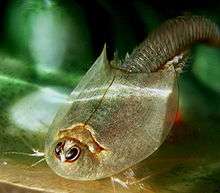 | |
| Triops longicaudatus | |
| Scientific classification | |
| Kingdom: | Animalia |
| Phylum: | Arthropoda |
| Subphylum: | Crustacea |
| Class: | Branchiopoda |
| Order: | Notostraca |
| Family: | Triopsidae |
| Genus: | Triops Schrank, 1803 |
| Species | |
| |
Triops is a genus of small crustaceans in the order Notostraca (tadpole shrimp). Some species are considered living fossils, with a fossil record that reaches back to the late Carboniferous, 300 million years ago. One species, Triops longicaudatus, is commonly sold in kits as a pet. Most Triops have a life expectancy of up to 90 days, and can tolerate a pH range of 6–10.
Relatives and fossil record
The genus Triops can be distinguished from the only other genus of Notostraca, Lepidurus, by the form of the telson (its 'tail'), which bears only a pair of long, thin caudal extensions in Triops, while Lepidurus also bears a central platelike process. Only 24 hours after hatching they already resemble miniature versions of the adult form.[1]
Triops are sometimes called "living fossils," since fossils attributable to this genus have been found in rocks of Carboniferous age, an estimated 300 million years ago,[2] and one extant species, Triops cancriformis, has hardly changed since the Jurassic period (approximately 180 million years ago).[3]
Triops can be found in Australia, Asia, South America, Great Britain,[4] and in some parts of North America where the climate is right. Some eggs stay unhatched from the previous group and hatch when rain soaks the area. Triops are fond of dirty, warm water filled with bacteria, which they eat.
Life cycle
Most species reproduce sexually, but some populations are dominated by hermaphrodites which produce internally fertilised eggs. Reproduction in T. cancriformis varies with latitude, with sexual reproduction dominating in the south of its range, and parthenogenesis dominating in the north.[5]
Triops eggs enter a state of extended diapause when dry, and will tolerate temperatures of up to 98 °C (208 °F) for 16 hours, whereas the adult cannot survive temperatures above 34 °C (93 °F) for 24 hours or 40 °C (104 °F) for 2 hours.[6] The diapause also prevents the eggs from hatching too soon after rain; the pool must fill with enough water for the dormancy to be broken.[6]
Taxonomy
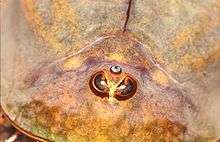
The name Triops comes from the Greek τρία (tría) meaning "three" and ὤψ (ops) meaning "eye".[7] The head of Triops longicaudatus bears a pair of dorsal compound eyes that lie close to each other and are nearly fused together. The compound eyes are generally sessile (not stalked). In addition, there is a naupliar ocellus (the "third eye") between them. The compound eyes are on the surface of the head, but the ocellus is deep within the head. All the eyes, however, are easily visible through the shell covering of the head.
Franz von Paula Schrank was the first author to use the genus name Triops,[8] coining it in his 1803 work on the fauna of Bavaria. Their German name was Dreyauge, which means 'three-eye' in English. He collected and described specimens from the same locality in Regensburg from which Schäffer, another naturalist who had studied the Notostraca, obtained his specimens in the 1750s. However, other authors, starting with Louis Augustin Guillaume Bosc, had adopted the genus name Apus for the organisms Schrank had named Triops
Ludwig Keilhack used the genus name Triops in his 1909 field identification key of the freshwater fauna of Germany. He suggested that the genus name Apus be replaced by Triops Schrank since an avian genus had already been described by Giovanni Antonio Scopoli under the name Apus.[8] However, Robert Gurney preferred the name Apus Schäffer. He suggested that the name '…Triops Schrank, may be returned to the obscurity from which it was unearthed'.[8] This controversy continued and was not resolved until the 1950s.
In his 1955 taxonomic review of the Notostraca, Alan R. Longhurst supported Keilhack's genus name Triops over Apus. Longhurst provided historical evidence to support this position.[8] The International Commission on Zoological Nomenclature (ICZN) followed Longhurst in their 1958 ruling on the usage and origin of the genus names Triops and Apus. They rejected the genus name Apus and instead recognized the genus name Triops Schrank, 1803 (ICZN name no. 1246).[8]
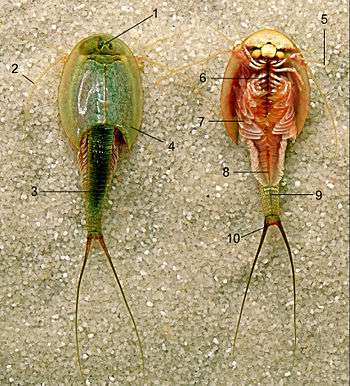
Although the taxonomy of the genus has not been reviewed since 1955, the following species are recognised:[9][10]
- Triops australiensis (Spencer & Hall, 1895)
- Triops baeticus Korn, 2010
- Triops cancriformis (Bosc, 1801)
- Triops emeritensis Korn & Pérez-Bote, 2010
- Triops gadensis Korn & García-de-Lomas, 2010
- Triops granarius (Lucas, 1864)
- Triops longicaudatus (LeConte, 1846)
- Triops mauritanicus Ghigi, 1921
- Triops newberryi Thomas, 1921
- Triops vicentinus Korn, Machado, Cristo & Cancela da Fonseca, 2010
Triops mauritanicus was considered a subspecies of T. cancriformis by Longhurst in 1955, but was given full species status again by Korn et al. in 2006.[11]
Note that for several of these species there are different varieties, some of which have recently been suggested as subspecies and even separate species. Triops longicaudatus, for example, may actually be several species lumped together, and Triops cancriformis is generally recognized as having three subspecies: Triops cancriformis cancriformis, Triops cancriformis mauretanicus, and Triops cancriformis simplex.[12] Also, the albino form has the special name of Beni-Kabuto Ebi.
Human uses
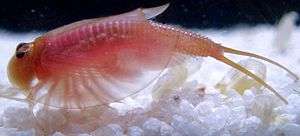
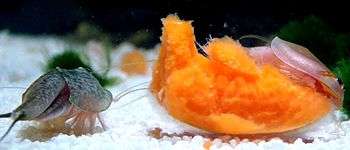
The species is considered a human ally against the West Nile virus, as the individuals consume Culex mosquito larvae. They also are used as a biological agent in Japan, eating weeds in rice paddies. The Beni-Kabuto Ebi Albino variant of Triops cancriformis is particularly valued for this purpose. In Wyoming, the presence of Triops longicaudatus usually indicates a good chance of the hatching of spadefoot frogs.
Dried eggs of Triops longicaudatus are sold in kits to be raised as aquarium pets, sold under the name of "aquasaurs", "trigons" or "triops". Among enthusiasts, Triops cancriformis is also common. Other species often encountered in captivity include Triops australiensis, Triops newberryi and Triops granarius. The red (albino?) forms of Triops longicaudatus and Triops cancriformis are also fairly common among enthusiasts and have been the subject of numerous YouTube videos.
Captive Triops are frequently kept in aquariums and fed a diet consisting mainly of carrots, shrimp pellets and dried shrimp.[13] Often they are also given living shrimp and daphnia as live prey.[14] Because they can feed on just about anything they are also fed lunch meat, crackers, potatoes etc.[15]
They will also feed themselves by grazing on algae and other grunge from the bottom and sides of the tank and on small particles clinging to sponge filters or to Marimo moss balls which are often cultured alongside Triops.
See also
References
- ↑ Denton Belk (2007). "Branchiopoda". In Sol Felty Light; James T. Carlton. The Light and Smith manual: intertidal invertebrates from central California to Oregon (4th ed.). University of California Press. pp. 414–417. ISBN 978-0-520-23939-5.
- ↑ Chip Hannum & Stuart Halliday. "An Introduction to Triops". MyTriops.com. Retrieved October 4, 2010.
- ↑ David A. Grimaldi & Michael S. Engel (2005). "Arthropods and the Origin of Insects". Evolution of the insects. Volume 1 of Cambridge Evolution Series. Cambridge University Press. pp. 93–118. ISBN 978-0-521-82149-0.
- ↑ Autumnwatch. 5 November 2015. BBC Two.
- ↑ Graham Bell (1982). The masterpiece of nature: the evolution and genetics of sexuality. Croom Helm applied biology series. Cambridge University Press. p. 243. ISBN 978-0-85664-753-6.
- 1 2 Patrick L. Osborne (2000). "Hot deserts and environmental factors". Tropical ecosystems and ecological concepts. Cambridge University Press. pp. 18–49. ISBN 978-0-521-64523-2.
- ↑ John Scarborough (1992). "Crustacea". Medical and biological terminologies: classical origins. Volume 13 of Oklahoma Series in Classical Culture. University of Oklahoma Press. pp. 75–81. ISBN 978-0-8061-3029-3.
- 1 2 3 4 5 Ole S. Møller, Jørgen Olesen & Jens T. Høeg (2003). "SEM studies on the early larval development of Triops cancriformis (Bosc) (Crustacea: Branchiopoda, Notostraca)" (PDF). Acta Zoologica. 84 (4): 267–284. doi:10.1046/j.1463-6395.2003.00146.x.
- ↑ Chip Hannum. "A Brief Overview of the Species". MyTriops.com. Retrieved October 4, 2010.
- ↑ Michael Korn, Andy J. Green, Margarida Machado, Juan García-de-Lomas, Margarida Cristo, Luís Cancela da Fonseca, Dagmar Frisch, José L. Pérez-Bote & Anna K. Hundsdoerfer (2010). "Phylogeny, molecular ecology and taxonomy of southern Iberian lineages of Triops mauritanicus (Crustacea: Notostraca)" (PDF). Organisms Diversity and Evolution. 10 (5): 409–440. doi:10.1007/s13127-010-0026-y.
- ↑ Michael Korn, Federico Marrone, Jose L. Pérez-Bote, Margarida Machado, Margarida Cristo, Luís Cancela de Fonseca & Anna K. Hundsdoerfer (2006). "Sister species within the Triops cancriformis lineage (Crustacea, Notostraca)" (PDF). Zoologica Scripta. 35 (4): 301–322. doi:10.1111/j.1463-6409.2006.00230.x.
- ↑ Species list. Mytriops.com. Retrieved on 2016-07-23.
- ↑ Frequently Asked Questions. triops.com
- ↑ Triops food. Mytriops.com (2003-10-28). Retrieved on 2016-07-23.
- ↑ Triops and their food. Triops-eggs.com. Retrieved on 2016-07-23.
External links
- Primeval-Shrimps.com > Triops – Collection of information with pictures and videos of Triops and other Branchiopoda.